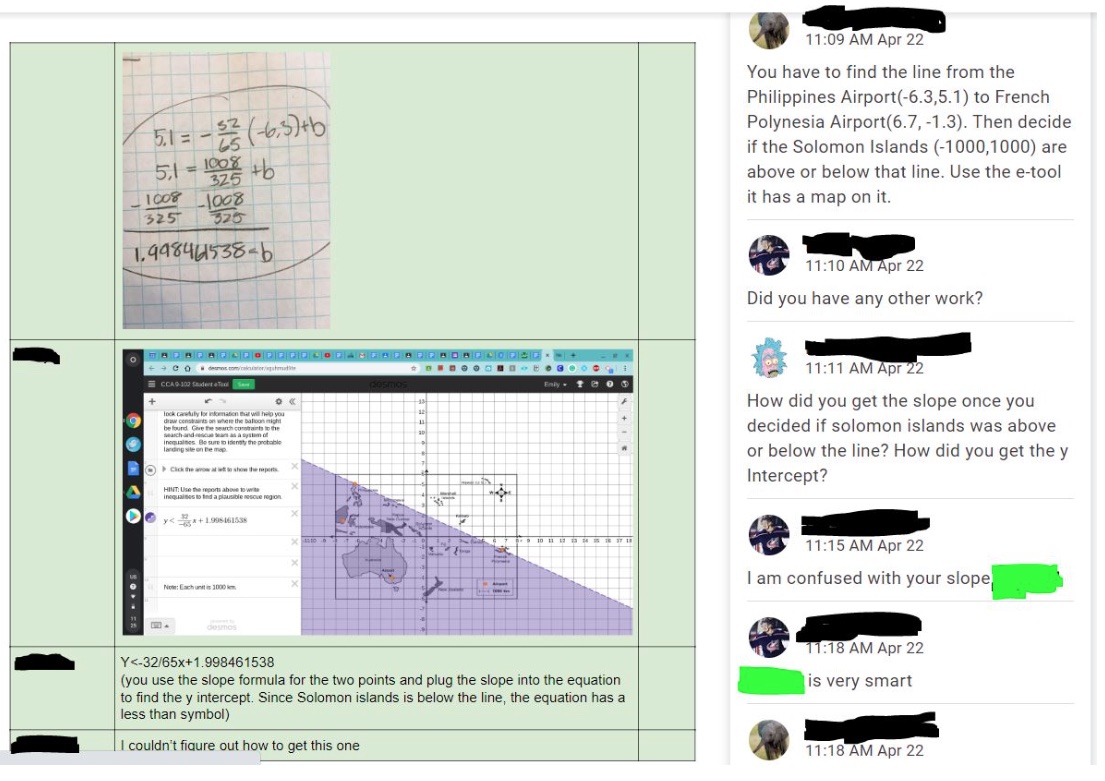Geoff Brown, Chagrin Falls, OH geoff.brown@chagrinschools.org
When our school shifted to remote instruction last March, I wanted my middle school students to interact with each other as much as possible, despite being isolated in their homes. I decided to ask them to continue to work in small teams to explore the same CPM lessons that they would have seen had they been in our classroom.
To enable the students to “construct viable arguments and critique the reasoning of others,” I transferred the problem number and a small amount of key information from the eBook to shared Google Docs. Each question from the lesson was inserted into a table and then each student was asked to paste their answer into the other rows of the table (See an example of CCG, Lesson 9.1.5 (gdoc)). Along the way, I hoped the students would read each other’s answers and make comments.
I asked everyone to attempt the problems to the best of their ability on Mondays and Wednesdays, and then we looked at the answer key together on Tuesday and Thursday mornings (See an example of the key for CCG, Lesson 9.1.5 (gdoc)). We were often able to share creative student work from the day before. To finish the lessons, I asked students to attempt normal Review & Preview problems on Tuesday and Thursday afternoons.
I was interested when some study teams decided to work through their lessons together, at the same time, and ask each other questions. This type of collaboration shows the potential of synchronous instruction, which our school has been planning to use in the fall. In the document pictured below, each team typed comments back and forth to other teams in the shared Google Doc as they explored CCA, Lesson 9.4.2. This virtual conversation was happening on a Wednesday morning, and I was excited to see it! The next morning, I shared this image with the rest of the class during our Thursday closure session.

Looking ahead to this fall, I think this strategy might be a good one to use for as many lessons as possible, especially if our classes will be synchronous with some people in the classroom and some at home. I can imagine having a Resource Manager sitting in my classroom showing materials to teammates in a Zoom breakout room. Then all teammates could discuss and type answers on a shared Google Doc. Finally, a Recorder/Reporter, sitting in their house, might announce a team’s conclusion to the whole-class in a Zoom meeting.
APPENDIX:
If you are interested in using Google Docs, here are a few strategies I developed.
- I originally planned to share a template of the note guide via Google Classroom and ask the students to make copies and give writing permission to me and their teammates. But, some students filed away the copies in surprising places, so ultimately I made the copies and placed them in a shared Google Folder. This way, all students were able to view every other team’s work, but they only edit their own. However, it took 10-15 minutes to make and share all the copies each morning, and the Turn in feature of Google Classroom was no longer usable.
- It was cumbersome to view student work when I had to open and scroll through many 20-page Docs. I am optimistic that, with synchronous classes, I can circulate through the work of a few teams at a time from my computer and offer the students more immediate feedback.
- I enjoyed seeing the students access outside resources, such as Desmos and Geogebra, to attempt problems and then paste screenshots or links from their work into these shared docs. The students did a nice job praising each other for creative work!
- For the formative assessment, we analyzed the keys for the Review & Preview problem every morning after they were due. My students also used DeltaMath.com once per week for additional individual practice and formative assessment.